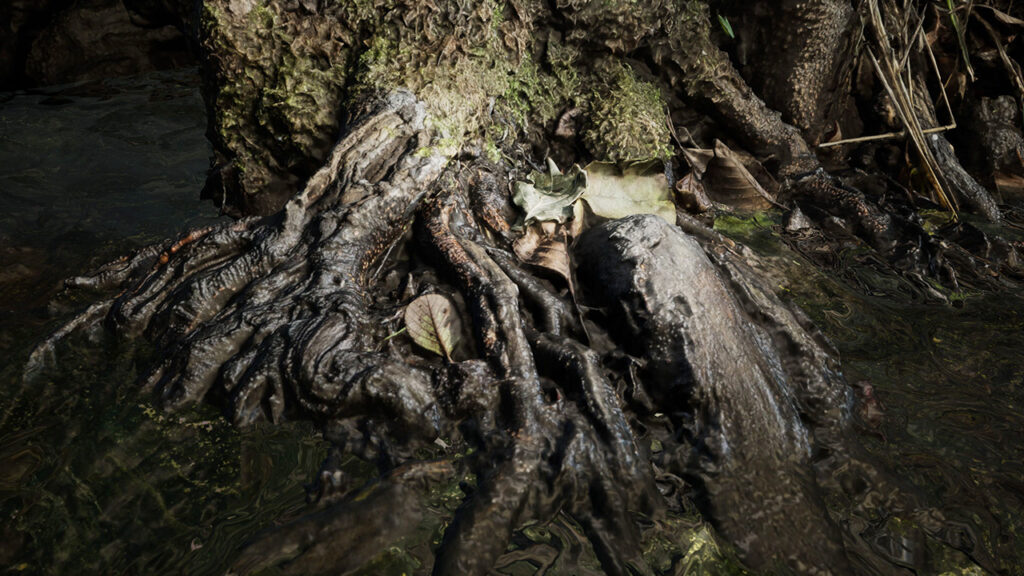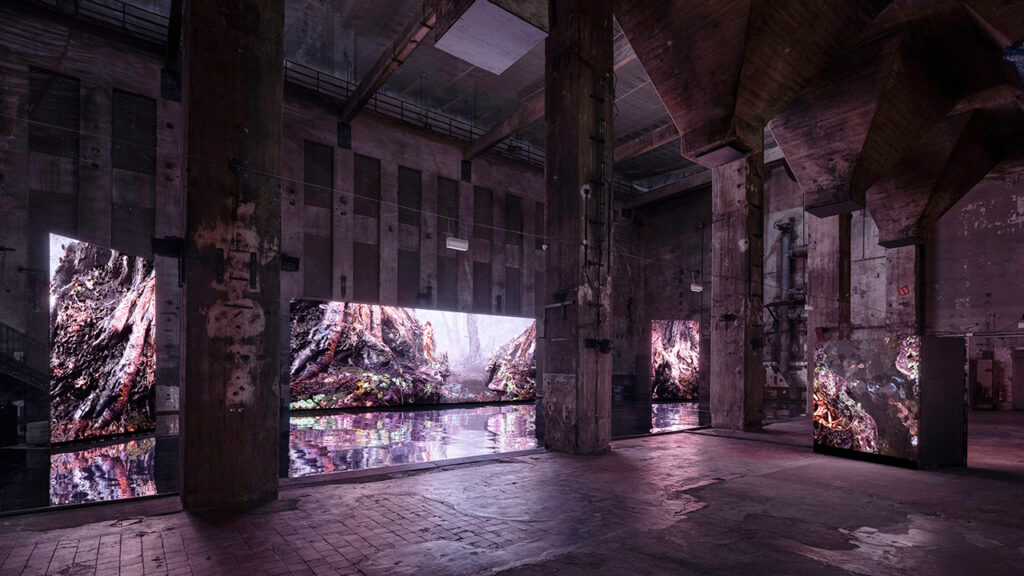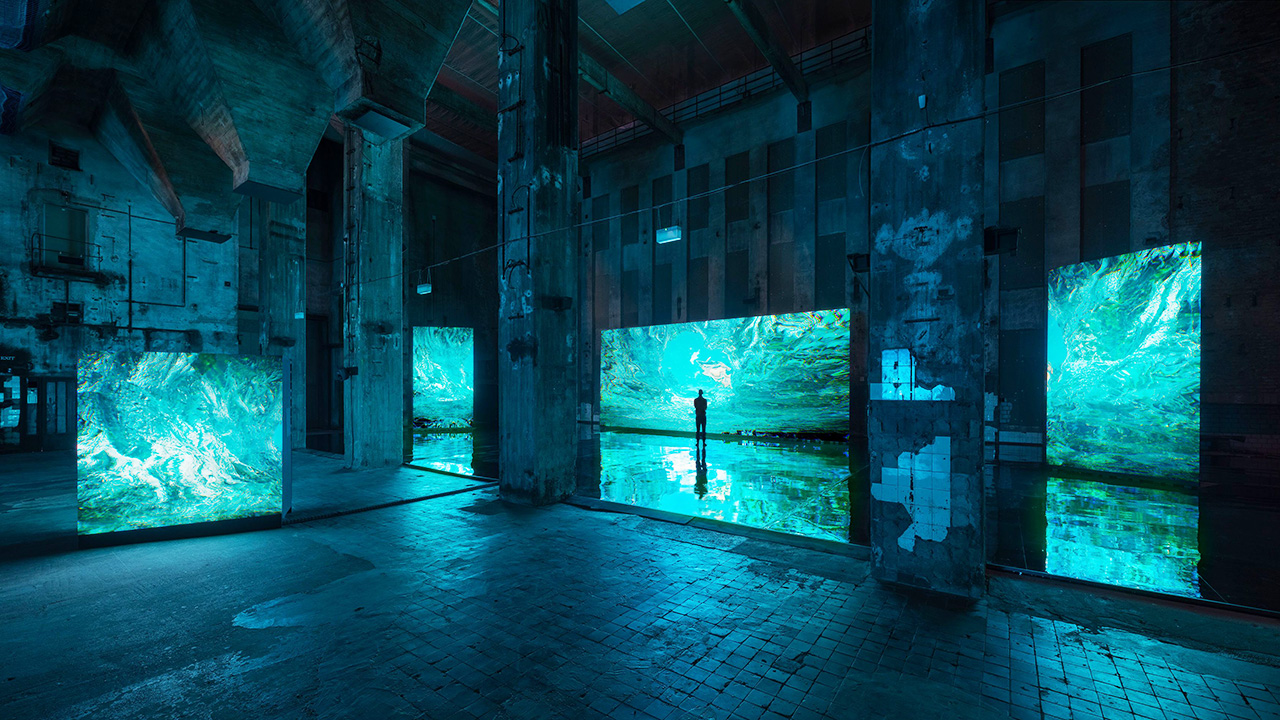On July 9, Berl-Berl, an exhibition created by Danish artist Jakob Kudsk Steensen and commissioned by art foundation Light Art Space (LAS), opened at the Berlin club Halle am Berghain, promising to immerse visitors in an ancient wetland landscape — Berlin-Brandenburg as it was 10,000 years ago. Harnessing cutting-edge technology, the installation pairs 3D renderings with a dynamic soundscape, produced by sound artist Matt McCorkle and featuring singer Arca, for a sensory encounter with a now-extinct swamp ecosystem, creating awareness around sustainability and the importance of preserving the natural environment.
Visitors entering the two-floored exhibition space are greeted by large-scale LED screens filled with dynamic wetland images created by Steensen through macro photogrammetry of natural specimens, sourced from the collections of the Museum für Naturkunde Berlin. Realized on Unreal Engine, a 3D creation tool most often used in the gaming industry, the site-specific installation “build[s] bridges,” in the words of Bettina Kames, Director of LAS, “between the art world, the tech world, and the science world.”

Still from the live simulation of Berl-Berl. Images: courtesy of the artist.
Below, Kames shares more with Jing Culture & Commerce about Steensen’s show and the Berlin-based organization’s work in propelling arts innovation through tech-centered exhibitions.
What drew Light Art Space to work with Jakob Steensen for this season’s program?
We invited Jakob because he’s one of the leading artists combining art with the latest technologies out of the gaming world, mixed realities, and photography.
Why did LAS choose Berghain as the venue for the exhibition?
We are in this nomadic state where we go to different locations within Berlin that have a certain aura, a certain character. We want to create this immersive environment and a very special experience, so for that, we often need a lot of space. Halle am Berghain is really huge, like 2,500 square meters, but it also works very well for a young foundation trying to build an audience. We are also currently in the process of securing our own permanent home and we’ve pledged to become 50 percent digital within the next two, three years, so it’s always about encountering different kinds of spaces.
As a foundation that’s worked with these various digital audiences, what have you observed about how audiences receive and interact with these tech-centered pieces?
There are different kinds of audiences. The main audience is just captured by this immersive experience and the mesmerizing visuals. I would say they just experience that in a very intuitive way. Then there’s the audience who has the technological knowledge, and we have people, artists or gamers who are just like, “Whoa, this is really incredible,” and they can tell what went into the development of this installation.


Above: Still from the live simulation of Berl-Berl. Below: Installation view of Berl-Berl at Halle am Berghain. Image: © Timo Ohler
Exhibiting these digital or tech-focused works requires additional time for build-outs or extra technical capacity. How does LAS facilitate the staging of these works to accommodate artists’ needs and requirements?
It’s something we’re working on as we speak, because for a foundation working at the intersection of art and tech, to provide the right infrastructure is key and quite challenging, to be honest. We are not there yet. For Jakob’s show, we have many ideas of what the afterlife of Berl-Berl could be. For example, offering a concert with Arca for 40,000 people to be streamed live from Berl-Berl. That’s technically quite challenging in terms of streaming, technology, and so forth. So we definitely will use this year to work on our infrastructure and hopefully make a lot more possible in the future.
What do you see for the future of immersive exhibitions like Berl-Berl?
I believe they have a huge future. What’s important is as an art exhibition, there’s a lot out there that’s immersive and that tries to be art but maybe is more entertainment, so there’s a fine line. For example, Berl-Berl lives in a game engine and the LED screens in the exhibition are only windows into this virtual world that he created. But what he also created is a completely new visual language for this virtual world using these gaming technologies and tools. And considering that gaming is such a huge market and entertains such a huge audience, I feel that it’s utterly important to develop new visual languages.
What’s the most important thing you want visitors to take away from the exhibition?
It would definitely be to create an awareness about the ecosystem of the wetlands and the swamps, and of these lost worlds and of how important they are. With LAS, we want to develop new visual languages and new formats, and we want to connect different worlds. That’s one of our key missions — to get from the exclusive to the inclusive and really bring people into our exhibitions that would never go to a museum, and hopefully they go to Berghain.



